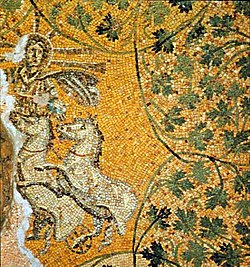Écu au soleil

Écu au soleil (auch: Écu sol, dt. Sonnenkrone[2]) ist der Name einer vom französischen König Ludwig XI. (1461–1483) im Jahr 1475 geschaffenen Écu, eine Goldmünze.
Beschreibung
Der Écu au soleil löste den Écu à la couronne ab, von dem er sich dadurch unterschied, dass über der Krone der Vorderseite eine kleine Sonne schwebte; die Rückseite zeigte das Lilienkreuz. Die Umschrift der Vorderseite lautete „LVDOVICVS DEI GRA[TIA] FRANCORVM REX“ (frz. Louis, par la grâce de Dieu, roi des Francs, dt. Ludwig, von Gottes Gnaden französischer König), die der Rückseite „XPC VINCIT XPC REGNAT XPC IMPERAT“ (XPC, ChRS in lateinischen Buchstaben, ist die griechische Abkürzung für Christus; frz. Le Christ vainc, le Christ règne, le Christ commande, dt. Christus siegt, Christus herrscht, Christus befiehlt).
Gewicht und Feingehalt der Münze schwankten: Der erste Écu au soleil wog 3,496 Gramm und enthielt 3,356 Gramm Gold, seit 1519 3,436 Gramm mit 3,257 Gramm, seit 1559 3,376 Gramm mit 3,235. Sein Nennwert lag erst bei 33 sols, seit 1487 bei 36 sols 3 deniers, seit 1516 bei 40 sols, seit 1533 bei 45 sols.
Unter Heinrich II. (1547–1559) wurde der Écu au soleil vom Henridor abgelöst.
Sonnenkrone in der Ikonographie
Die alte Kirche bildete Jesus Christus noch als Sol invictus mit Sonnenkrone ab.
Literatur
- Artikel Écu au soleil, in: Friedrich von Schrötter: Wörterbuch der Münzkunde, Berlin [u. a.] 1930, S. 170f.
Einzelnachweise
- ↑ Mosaiktitel: 'Christus als Sol Invictus', interpretiert als Christus-Sol. Die frühen Heidenchristen kombinieren hier urchristlichen und heidnischen Glauben in diesem Mosaik von Jesus Christus als Sonnengott. Der triumphierende Gott Jesus wird von zwei Pferden in seinem Sonnenwagen gezogen. Die Weinranken des Dionysos, der nach griechisch-römischer Mythologie aus der Unterwelt wiederkam/auferstand, werden zu Weinranken Jesu.
- ↑ James Ede: A view of the gold and silver coins of all nations. J.M. Richardson, London 1808 (englisch, 73 S., Volltext in der Google-Buchsuche). S. 54
Weblinks
Auf dieser Seite verwendete Medien
*Ceiling Mosaic - Christus helios, the mosaic of Sol in Mausoleum M, which is interpreted as Christ-Sol (Christ as the Sun).
Detail of vault mosaic in the Mausoleum of the Julii. From the necropolis under St. Peter's Mid-3rd century, Rome.
Mosaic from the Vatican Necropolis under St. Peter's Basilica, on the ceiling of the Tomb of the Julii. Representation of Christ as the sun-god Helios or Sol Invictus riding in his chariot. Dated to the 3rd century AD.
"Early Christian and pagan beliefs are combined in this third century mosaic of Christ as a sun-god. The triumphant Christ/god, with rays shooting from his head, is pulled aloft by two rearing horses in his chariot. The Dionysian vines in the background become the vines of Christ."
- Title: Christ as Sol Invictus
- Late 3rd century
"The First Apology" by St. Justin Martyr, an early Christian, quotes Psalm 19:5-6, a verse that was very popular with early Christians. It was associated with the ancient Christian custom of praying toward the East, the direction of Christ's Ascension and second coming, instead of toward Jerusalem as Jews did:
"And hear how it was foretold concerning those who published His doctrine and proclaimed His appearance, the above-mentioned prophet and king [David] speaking thus by the Spirit of prophecy. "....In the sun has He set His tabernacle, and he as a bridegroom going out of his chamber shall rejoice as a giant to run his course."
Christ was also associated with "the Sun of justice with its healing rays", a Messianic image from Malachi 3:20.
From "THE BONES OF ST. PETER : The First Full Account of the Search for the Apostle's Body (Doubleday, 1982) by John Evangelist Walsh"; plate 7 shows a larger black-and-white image; p.26 says that three other mosaics in the tomb on the walls show (a) Jonah falling from a ship and being swallowed by the whale, (b) a fisherman standing on rocks fishing (c) the good shepherd with a sheep across his shoulders. The mosaic on the dome comes half-way down the walls. The rays of light "strongly suggest the form of a cross." The tomb was decorated about 250 with these motifs. The damage to the mosaic on the left is in fact a hole in the centre of the ceiling. The tomb was accessed from the street of pagan Roman tombs, and the access covered by a slab. When this was lifted, the hole in the middle of the dome was accessible. The tomb is described, not as a papal tomb, but as the "tomb of the golden mosaic." Originally it contained a pagan burial of a child and no adornment. Around 250 the family had converted to Christianity, and redecorated it. Three Christian burials were located under the floor. A story from 1574 relates how workmen had opened "a tomb with golden mosaics and two white horses", and found a body on a slab on the floor covered with quicklime; the body was not present when the tomb was located again during the 1941 excavations.(c) Classical Numismatic Group, Inc. http://www.cngcoins.com, CC BY-SA 3.0
KINGS of France. Louis XII of France. 1498-1514.
- AV écu au Soleil (27mm, 3.42 g). Paris mint. Struck 1498.
- Crowned coat-of-arms with sun above; legend starts with crowned lis, name as LUdOVICVS, pellet under 18th letter
- Floreate cross with quadrilobe in center; legend starts with crowned lis, pellet under 18th letter.
- Duplessy 647; Ciani 900.


